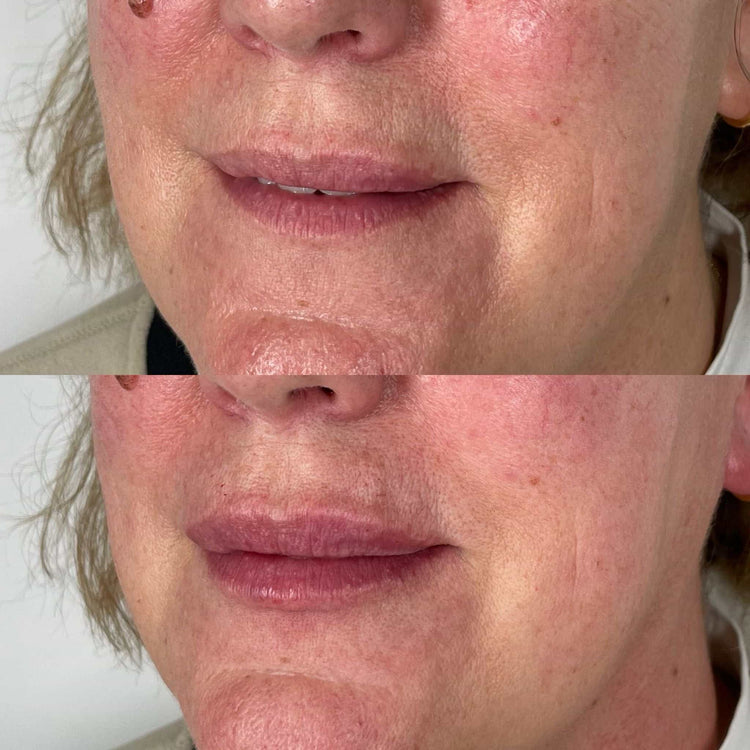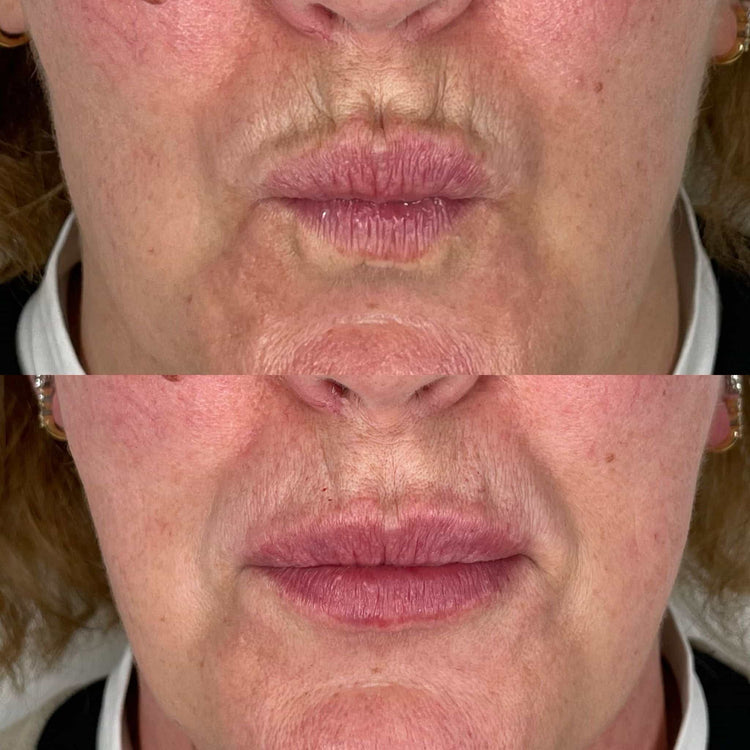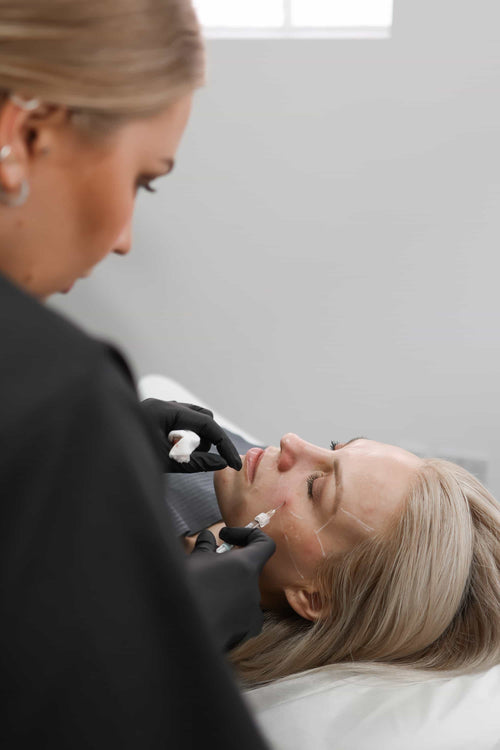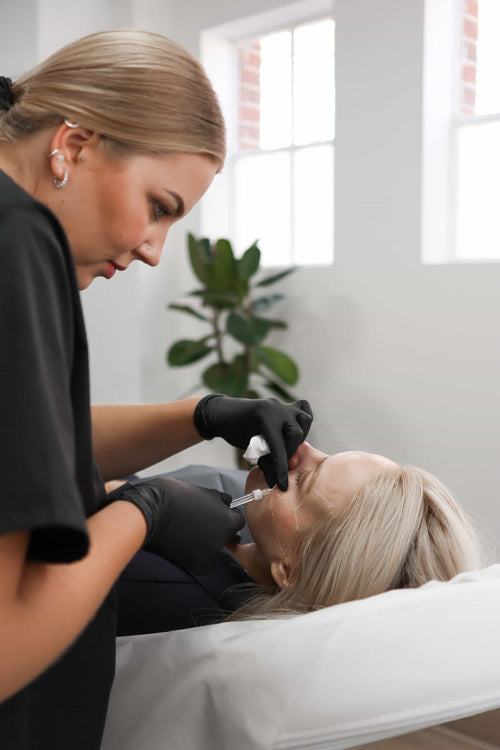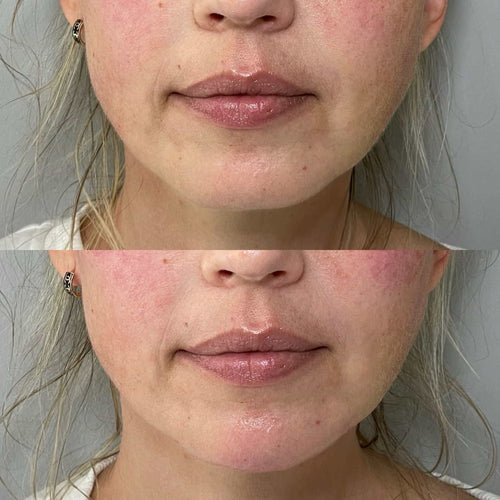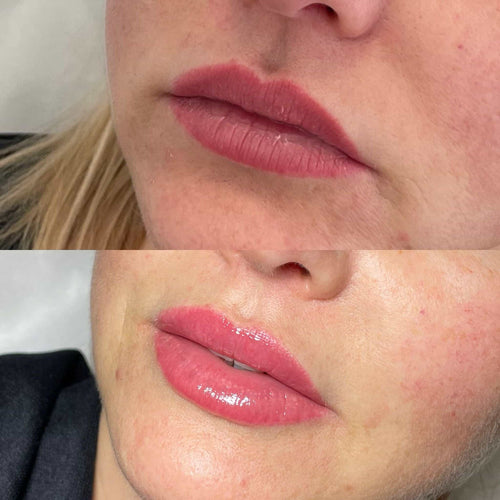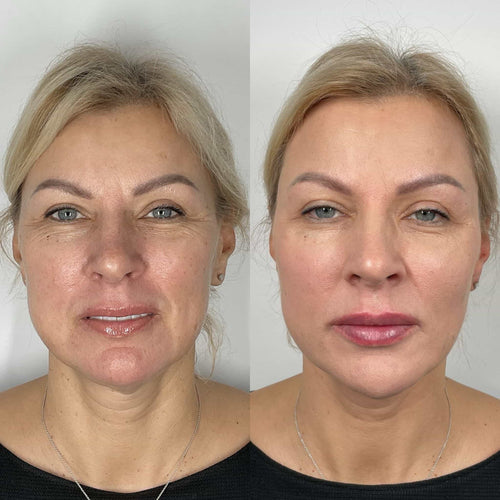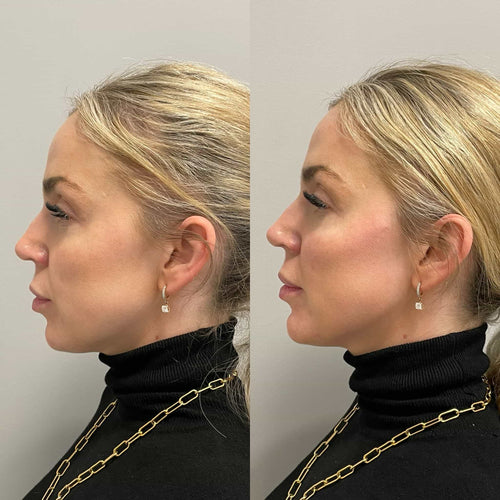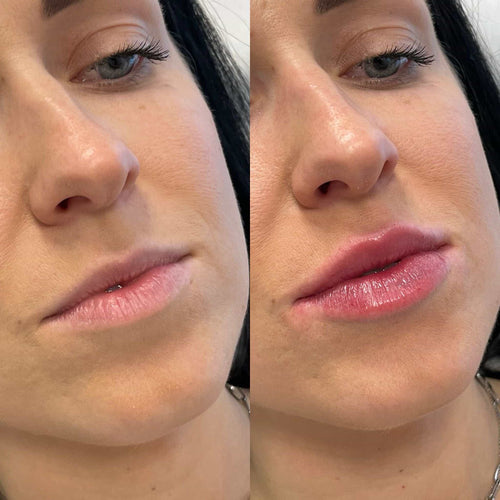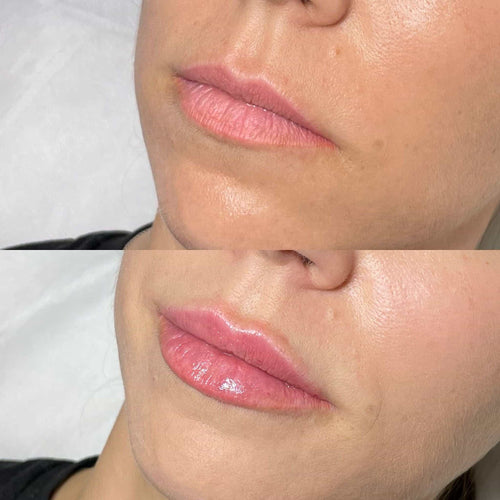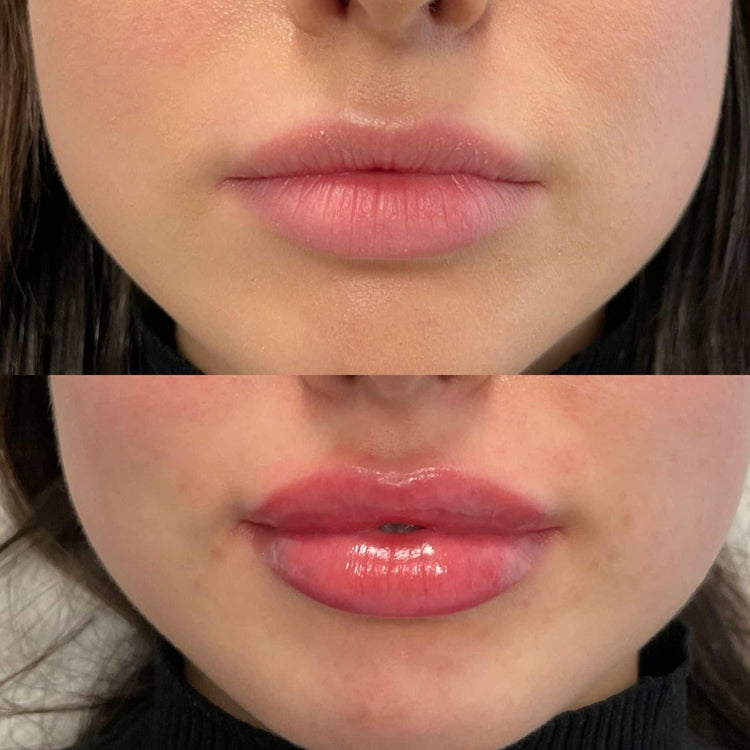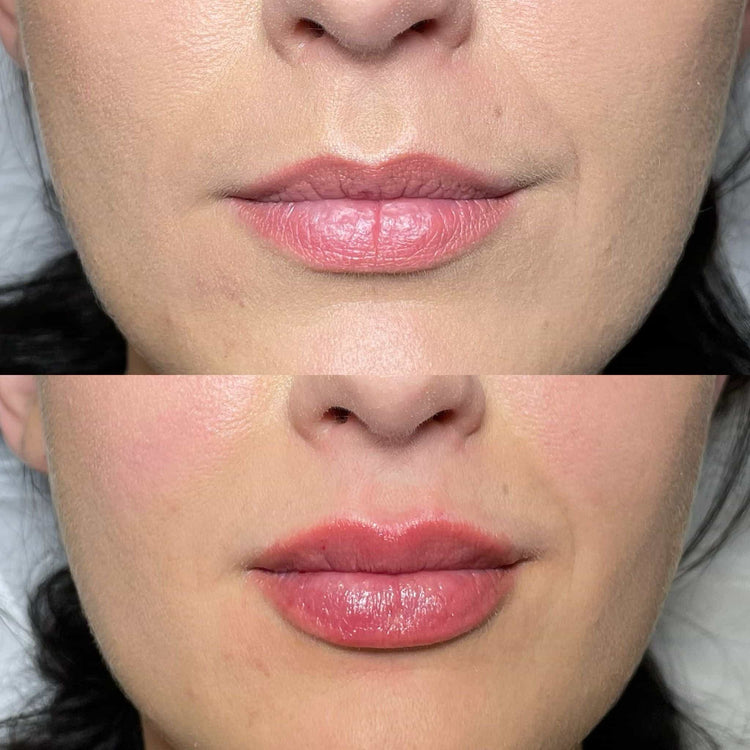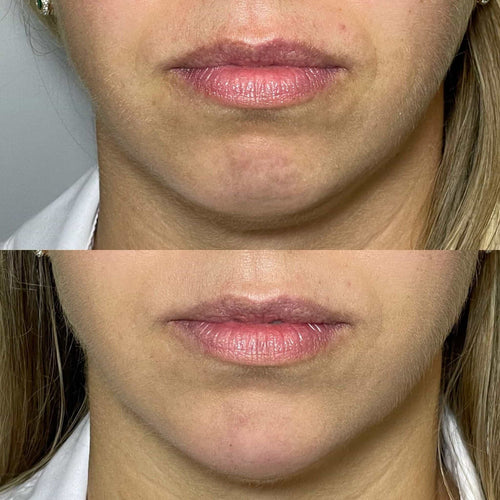Book a Dermal Filler Consultation with Dr. Laura Geige Today
Causes of Lip Filler Bumps
Infection Risk
Lip filler bumps are a common side effect that can occur after getting lip fillers, causing discomfort and unsightly lumps under the skin.
There are several causes of lip filler bumps, including:
-
Overfilling or using too much filler material
-
Inadequate numbing or anesthesia during treatment
-
Using a filler that is not suitable for the individual’s skin type or facial structure
-
Insertion of the filler at an angle or with excessive pressure
-
Using a needle that is too large or too small for the filler
-
Infection or abscess formation after treatment
The risk of infection after lip fillers is also a significant concern.
Infection can occur when bacteria enter the body through a break in the skin, such as during the insertion of the filler. Some common signs of infection include:
-
Redness and swelling around the treated area
-
Pus or discharge from the treated area
-
Fever or chills
-
Coldness or numbness in the treated area
-
Increased pain or discomfort in the treated area
To reduce the risk of infection, it is essential to follow proper aftercare instructions provided by your practitioner.
This may include avoiding strenuous activities, washing the treated area gently with soap and water, and applying a topical antibiotic ointment as directed.
It’s also crucial to seek medical attention immediately if you experience any signs of infection or if the bump does not resolve on its own within a few weeks after treatment.
Other causes of lip filler bumps may include:
-
Granuloma formation, which is an immune response to the filler material
-
Abscess formation, which can be treated with antibiotics or surgical drainage
-
Trauma or injury to the skin during treatment
-
Reaction to the local anesthetic used during treatment
It’s essential to choose a qualified and experienced practitioner who uses sterile equipment and follows proper technique to minimize the risk of complications.
A reputable practitioner will also be able to assess your individual needs and provide personalized advice on how to manage lip filler bumps.
With proper treatment and aftercare, most lip filler bumps can resolve on their own within a few weeks or months.
One common cause of lip filler bumps is infection, which can occur when bacteria or other pathogens enter the body through contaminated equipment or injection site.
Infection is a common cause of lip filler bumps, which can be caused by bacterial infections such as abscesses or cellulitis.
When bacteria enter the body through contaminated equipment or injection sites, it can lead to an inflammatory response, resulting in the formation of bumps under the skin.
The most common type of infection that causes lip filler bumps is a staphylococcal infection, which is caused by the bacterium Staphylococcus aureus.
Other types of infections, such as streptococcal or fungal infections, can also cause lip filler bumps in some cases.
The symptoms of an infection that causes lip filler bumps may include redness, swelling, warmth, and tenderness around the injection site.
Pus may also drain from the bump, which can be a sign of a more serious infection.
It’s essential to seek medical attention immediately if you experience any symptoms of infection after getting lip fillers.
Medical professionals may prescribe antibiotics or other treatments to help clear up the infection and reduce swelling.
However, it’s also possible for lip filler bumps caused by infection to become abscesses, which can be more serious and require drainage or surgical treatment.
Another cause of lip filler bumps is granuloma formation, which occurs when the body’s immune system responds to the presence of foreign particles, such as those from lip fillers.
Granulomas are typically small, painless bumps that can appear at the injection site and may resolve on their own over time.
However, in some cases, granulomas can become large and painful, or they may cause scarring or discoloration around the injection site.
Other possible causes of lip filler bumps include allergic reactions to the ingredients used in lip fillers, such as lidocaine or calcium hydroxylapatite.
Allergic reactions can cause a range of symptoms, including redness, swelling, itching, and burning at the injection site.
In severe cases, an allergic reaction can lead to anaphylaxis, which is a life-threatening medical emergency.
Cosmetic causes of lip filler bumps include scarring or irritation caused by improper technique during the procedure, or by using substandard lip fillers that are not designed for human use.
Additionally, the shape and size of the lips can also cause lip filler bumps to form, especially if the filler is placed in areas with a lot of fatty tissue.
Genetic causes of lip filler bumps include inherited conditions such as keloids or hypertrophic scarring, which can make it more likely for bumps to form after lip fillers.
Other genetic factors may also play a role in the formation of lip filler bumps, although the exact mechanisms are not yet fully understood.
Immune Response
Causes of lip filler bumps are multifaceted and can be attributed to several factors, including the type of filler material used, the individual’s immune system response, and the technique employed by the injector.
One common cause of lip filler bumps is the use of hyaluronic acid fillers, which are the most popular type of filler material. When injected into the skin, hyaluronic acid molecules can trigger an immune response, causing inflammation and the formation of granulomas – small areas of tissue that can lead to the development of bumps or nodules.
Another cause of lip filler bumps is the use of calcium hydroxylapatite fillers. These fillers are made from minerals found in bone and can cause a foreign body reaction, leading to an immune response and inflammation.
Some individuals may be more prone to developing lip filler bumps due to their genetic makeup or underlying medical conditions. For example, people with a history of autoimmune disorders such as lupus or rheumatoid arthritis may be more susceptible to adverse reactions to filler materials.
The technique employed by the injector can also play a role in the development of lip filler bumps. Injecting fillers too close together or using too much filler material can cause inflammation and irritation, leading to the formation of bumps or nodules.
Immune response is a complex process that involves the activation of immune cells, such as macrophages and T-cells, which recognize the filler material as foreign and trigger an inflammatory response. This response can lead to the release of cytokines, chemokines, and other signaling molecules that promote inflammation and tissue damage.
The type of immune response triggered by lip fillers can vary depending on the individual and the specific filler material used. Some people may experience a mild, transient response, while others may develop a more severe, chronic reaction.
Arrange Your Dermal Filler Consultation with Dr. Laura Geige
Chronic immune responses can lead to the development of granulomas, which are collections of immune cells that surround and damage the filler material. Over time, these granulomas can cause scarring and tissue damage, leading to the formation of lip filler bumps.
In some cases, lip filler bumps may be caused by an allergic reaction to the filler material. This type of response is often seen in individuals who are sensitive or allergic to certain ingredients found in fillers, such as lidocaine or sodium chloride.
It’s worth noting that lip filler bumps can also be caused by other factors, including:
- Injecting fillers too close to the surface of the skin
- Using expired or contaminated filler material
- Having a poor injection technique
- Mixing different types of filler materials
In order to prevent lip filler bumps, it’s essential to find a qualified and experienced injector who uses high-quality filler materials and employs proper technique. Regular maintenance treatments can also help to prevent the formation of bumps or nodules.
Another possible cause of lip filler bumps is an overactive immune response to the filler material. This can lead to inflammation and the formation of bumps, nodules, or lumps under the skin.
In some cases, lip filler bumps can be caused by an overactive immune response to the filler material.
This reaction occurs when the body mistakenly identifies the filler as foreign and mounts an immune response against it.
The resulting inflammation can cause swelling, redness, and the formation of bumps, nodules, or lumps under the skin.
These bumps can be tender to the touch and may be accompanied by pain, itching, or stinging sensations.
In severe cases, an overactive immune response can lead to more serious complications, such as abscesses or granulomas.
The immune response to lip fillers can also cause delayed reactions, which may appear hours or even days after the initial filler injection.
It is essential to note that not all lip filler bumps are caused by an overactive immune response, and other factors such as improper technique, using low-quality fillers, or having certain medical conditions can contribute to their development.
In some cases, lip filler bumps may resolve on their own without treatment, although this is often a lengthy process that can take several weeks or even months.
However, in many instances, it is necessary to seek professional help from a qualified healthcare provider or dermatologist to treat the underlying cause of the bump and prevent further complications.
A thorough evaluation by a medical professional will typically involve assessing the lip filler used, checking for any signs of infection, and examining the affected area carefully.
Depending on the severity of the condition, treatment may include administering antibiotics to combat infections, draining abscesses or granulomas, or using corticosteroid injections to reduce inflammation.
In some cases, surgical removal of the filler material may be necessary in severe cases where other treatments have failed.
It is also crucial for individuals considering lip fillers to choose a qualified and experienced provider who uses high-quality products and follows proper technique to minimize the risk of complications.
Symptoms and Treatment Options
Identifying Symptoms
Symptoms of lip filler bumps can vary from person to person, but they often present as small, raised, or **lumpy** nodules under the skin. These bumps may be red, swollen, or inflamed, and can be tender to the touch.
In some cases, lip filler bumps can be painful and may cause discomfort while eating, drinking, or speaking. They may also be noticeable in photos or when smiling, which can be embarrassing for those affected.
Other symptoms of lip filler bumps include:
- Swollen or inflamed skin around the bump
- Increased sensitivity to the touch
- Pain or tenderness in the area
- Redness or discoloration of the surrounding skin
Treatment options for lip filler bumps depend on the cause and severity of the symptoms. If the bumps are caused by an allergic reaction to the filler material, they may be treated with:
Antihistamines: Over-the-counter antihistamines such as diphenhydramine or chlorpheniramine can help alleviate itching, redness, and swelling.
Corticosteroid injections: Injecting a corticosteroid into the affected area can help reduce inflammation and swelling.
Surgical removal of the filler is usually not recommended as it can lead to scarring, unevenness, and a loss of lip volume. However, in some cases, the filler may need to be removed surgically if it causes significant discomfort or interferes with daily activities.
In cases where the symptoms are caused by a foreign body reaction, such as an allergic response or an infection, medical treatment may include:
Topical antibiotics: Applying topical antibiotics such as neomycin or bacitracin can help clear up any infections.
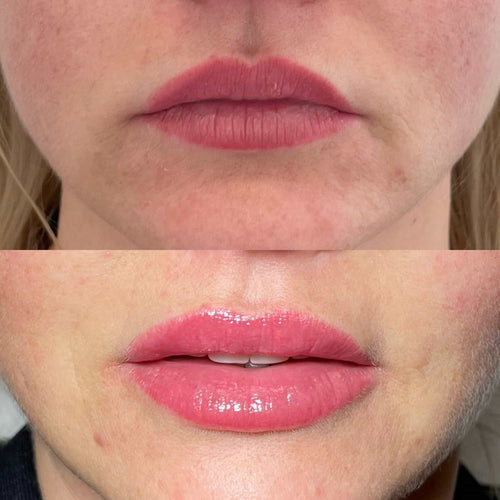
Oral antibiotics: In more severe cases, oral antibiotics may be prescribed to treat bacterial infections.
It’s also essential to note that some lip filler bumps may be caused by **filler migration**, where the filler material moves under the skin. This can cause lumps or bumps to form, and it’s essential to seek medical attention if symptoms persist or worsen over time.
To prevent lip filler bumps from forming, it’s crucial to follow proper after-care instructions provided by your healthcare professional or cosmetic injector. This includes:
Avoiding** strenuous activities that can cause swelling
Keeping the area clean and dry
Avoiding** smoking, as it can slow down the healing process
Scheduling regular follow-up appointments with your healthcare professional or cosmetic injector to monitor the condition of your lips and fillers.
It’s also essential to choose a reputable and experienced cosmetic injector who uses high-quality fillers and follows proper after-care instructions to minimize the risk of complications, including lip filler bumps.
Bumps from lip fillers can present as redness, swelling, bruising, itching, or pain at the injection site. According to the American Academy of Dermatology, these symptoms often resolve on their own within a few days.
Bumps from lip fillers can be an unsettling and unsightly symptom, but in most cases, they are temporary and resolve on their own within a few days.
The symptoms of lip filler bumps can vary from person to person, but common signs include redness, swelling, bruising, itching, or pain at the injection site.
These bumps are usually caused by the immune system’s reaction to the foreign substance used in fillers, such as hyaluronic acid or calcium hydroxylapatite.
The American Academy of Dermatology reports that these symptoms often resolve on their own within a few days, but it can take up to two weeks for the area to fully heal.
In the meantime, there are several treatment options available to help alleviate the discomfort and speed up the healing process.
Topical creams or gels containing ingredients such as lidocaine, benzocaine, or menthol can be applied directly to the affected area to numb the skin and reduce pain.
Over-the-counter pain relievers like ibuprofen or acetaminophen can also help manage any discomfort or inflammation.
In some cases, a cold compress or ice pack may be used to reduce swelling and ease bruising.
For more severe cases of lip filler bumps, corticosteroid injections may be prescribed by a dermatologist to reduce inflammation and promote healing.
Maintaining good skin care habits, such as keeping the area clean and moisturized, can also help prevent bacterial infections and promote healthy tissue repair.
It’s essential to note that in some cases, lip filler bumps can be a sign of an allergic reaction or infection, which may require medical attention.
If you experience any of the following symptoms, seek medical attention immediately:
Severe pain or swelling that worsens over time
Pus or discharge from the affected area
Redness or warmth that spreads beyond the injection site
Fever or chills
A foul odor from the affected area
If you’re concerned about lip filler bumps, it’s best to consult with a board-certified dermatologist or plastic surgeon for personalized advice and treatment.
Treatment Options for Lip Filler Bumps
Lip filler bumps, also known as lip filler lumps or lip filler reactions, are an unwanted and unsightly side effect that can occur after getting lip fillers, such as hyaluronic acid (HA) or collagen.
These bumps can vary in size, shape, and color, but they usually appear as small, raised lesions on the skin’s surface. They can be painful, itchy, or tender to the touch, and may cause discomfort or swelling around the treated area.
There are several possible causes of lip filler bumps, including:
- Overfilling: When too much filler is injected into the lip area, it can cause the body to react and form a bump.
- Poor technique: If the filler is not injected correctly, it can lead to uneven distribution or lumps in the treated area.
- Allergic reactions: Some people may be allergic to certain ingredients in the filler, causing an immune response that leads to a bump.
- Infection: Bacterial, viral, or fungal infections can cause lip filler bumps, especially if the filler is not sterile or if proper aftercare is not followed.
The treatment options for lip filler bumps vary depending on the underlying cause. Here are some possible treatments:
- Incision and drainage (I&D): This involves making a small incision in the bump to drain its contents and relieve pressure. In some cases, antibiotics may be prescribed to prevent infection.
- Steroid injections: Steroids can help reduce inflammation and swelling caused by an allergic reaction or infection.
- Aspiration: A needle is used to aspirate (suck out) the bump, followed by administration of antibiotics or other treatments as needed.
- Laser therapy: Laser light can help reduce inflammation and break up blood clots that may be contributing to the bump.
- Massaging the area: Gently massaging the treated area with your fingers or a spatula (after it has healed) can help break up adhesions and stimulate collagen production, which may help flatten the lump.
In some cases, lip filler bumps can be persistent or recurring. If you experience frequent or severe bumps, it’s recommended to consult a qualified healthcare professional or a board-certified dermatologist for further evaluation and treatment.
Preventing lip filler bumps is always better than trying to treat them. To minimize the risk of lumps, make sure to:
- Choose a qualified practitioner: Ensure that your injector has experience with the type of filler you’re using and follows proper techniques.
- Follow pre- and post-treatment instructions: Follow your practitioner’s advice on before and aftercare to minimize the risk of complications.
- Be realistic about results: Understand that lip fillers are not a permanent solution, and it’s normal for some swelling or lump formation during the recovery period.
- Monitor your body’s reaction: If you experience any unusual symptoms or reactions after getting lip fillers, seek medical attention immediately.
According to the Journal of Clinical and Aesthetic Dermatology, treatment options for lip filler bumps may include warm compresses, massage, or antibiotics to reduce inflammation and promote healing. In severe cases, surgery may be necessary.
A lip filler bump, also known as a granuloma or abscess, can occur after receiving lip fillers, causing redness, swelling, and potentially painful lumps under the skin.
The symptoms of a lip filler bump may include:
Redness and inflammation around the affected area
Swelling and lump formation under the skin
Pain or tenderness in the face
Difficulty eating, speaking, or smiling due to the swelling
The severity of lip filler bumps can vary from mild to severe, with some cases requiring more aggressive treatment than others.
In general, treatment options for lip filler bumps may include:
Book Your Dermal Filler Session with Dr. Laura Geige Today
Warm compresses to reduce inflammation and promote healing
Massage to break up the bump and encourage drainage
Topical or oral antibiotics to treat bacterial infections and prevent further inflammation
In some cases, a healthcare professional may also recommend retinoid creams or other topical treatments to help reduce inflammation and promote collagen production.
Surgery may be necessary in more severe cases, where the bump has become infected or is causing significant discomfort or disfigurement.
A surgeon may need to drain the abscess, remove any dead tissue, and smooth out the affected area to restore a natural appearance.
It’s essential to seek medical attention as soon as possible if you experience any symptoms of a lip filler bump, as prompt treatment can help prevent long-term scarring or further complications.
A combination of conservative treatments, such as warm compresses and antibiotics, may be more effective than surgery in mild cases, but the best course of treatment will depend on the individual’s specific situation and the severity of the symptoms.
It’s also crucial to note that lip filler bumps can occur in people who have not received fillers at all, which can be a sign of an allergic reaction or other underlying condition.
A thorough examination and diagnosis by a qualified healthcare professional are necessary to determine the cause of the bump and develop an effective treatment plan.
In some cases, lip filler bumps may resolve on their own without treatment, but this is often not the case, and prompt attention can help prevent further complications.
Preventing Future Occurrences
Symptoms of lip filler bumps can vary from person to person, but common signs include redness, swelling, and inflammation around the injection site. Some people may experience a lump or a bump under the skin, which can be firm or soft to the touch. In some cases, the bump may be accompanied by pain, itching, or stinging sensations.
Less severe symptoms may resolve on their own within a few days, while more severe reactions may require medical attention. In rare cases, lip filler bumps can become infected, leading to more serious complications such as abscesses or cellulitis. If you experience any of the following symptoms, seek medical attention immediately:
– Increasing redness or swelling that spreads beyond the initial injection site
– Pus or discharge from the affected area
– Fever or chills
– Increased pain or tenderness to the touch
Once the symptoms have resolved, it’s essential to take steps to prevent future occurrences of lip filler bumps. To do this, choose a reputable and licensed practitioner who uses high-quality products and follows proper injection techniques.
When selecting a practitioner, make sure they have experience with your desired treatment and use sterile equipment to minimize the risk of infection. It’s also crucial to follow pre- and post-treatment instructions carefully, including any medications or topical creams that may be prescribed.
In terms of prevention, some people find it helpful to take anti-inflammatory medication before and after their treatment to reduce swelling and inflammation. Additionally, applying a cold compress or ice pack to the affected area can help to reduce swelling and ease discomfort.
For more severe reactions, oral antibiotics may be prescribed to prevent infection. In rare cases, corticosteroid injections may be necessary to reduce inflammation and promote healing.
In some cases, lip filler bumps may be caused by an allergic reaction or sensitivity to the product used. If you experience any symptoms of an allergic reaction, such as hives, itching, or difficulty breathing, seek medical attention immediately.
To minimize the risk of future occurrences, it’s essential to choose a reputable and licensed practitioner who uses high-quality products. You should also follow all post-treatment instructions carefully, including any medications or topical creams that may be prescribed.
Maintaining good skin health through regular exercise, a balanced diet, and sufficient sleep can also help to reduce the risk of lip filler bumps. Avoiding excessive sun exposure and using sunscreen daily can also help to prevent hyperpigmentation and other complications.
In terms of treatment options, there are several choices available for lip filler bumps. In some cases, the bump may resolve on its own within a few days with minimal treatment. However, more severe reactions may require medical attention, including antibiotics or corticosteroid injections.
Avoid attempting to pop or squeeze the bump, as this can lead to further inflammation and scarring. Instead, apply a cold compress or ice pack to the affected area to reduce swelling and ease discomfort. Over-the-counter pain medication may also be helpful in managing any associated pain or discomfort.
For more severe cases, your practitioner may recommend further treatment options, such as steroid injections or oral antibiotics. In rare cases, surgery may be necessary to remove the bump or underlying tissue.
To minimize the risk of future occurrences, it’s essential to maintain good skin health through regular exercise, a balanced diet, and sufficient sleep. You should also avoid excessive sun exposure and use sunscreen daily to prevent hyperpigmentation and other complications.
The Food and Drug Administration recommends choosing a qualified healthcare professional or dermatologist who has experience with lip fillers and follows proper sanitation and safety procedures to minimize the risk of complications, including lip filler bumps.
Lip filler bumps are a common complication that can occur after receiving lip fillers, and they can be caused by various factors such as improper injection technique, allergic reactions, or infection.
The symptoms of lip filler bumps can range from mild to severe and may include:
- Swollen lips
- Pink or red discoloration around the treated area
- Tenderness or pain in the affected lip
- Itching, burning, or stinging sensations
- Small, hard bumps or nodules under the skin
- Slight bruising or swelling of the surrounding tissue
In some cases, lip filler bumps can be caused by an allergic reaction to the filling material, such as hyaluronic acid or collagen. If you experience any symptoms after receiving lip fillers, it’s essential to consult with a qualified healthcare professional or dermatologist who has experience with lip fillers and follows proper sanitation and safety procedures.
Treatment options for lip filler bumps vary depending on the severity of the reaction and may include:
- Rest and ice packs to reduce swelling and pain
- Simple antibiotics or antihistamines to treat minor infections or allergic reactions
- Aspirin or ibuprofen to relieve pain and reduce inflammation
- In severe cases, steroid injections or surgical removal of the filler may be necessary
- Preventing future lip filler complications by choosing a qualified healthcare professional or dermatologist who uses proper sanitation and safety procedures
It’s essential to note that not all lip filler bumps can be treated with these options, and some cases may require surgical intervention. In rare instances, lip filler bumps can cause more serious complications, such as permanent scarring or nerve damage.
To minimize the risk of lip filler bumps and ensure safe treatment, it’s crucial to choose a qualified healthcare professional or dermatologist who:
- Has extensive experience with lip fillers
- Folows proper sanitation and safety procedures
- Uses FDA-approved filling materials
- Cares for patients’ individual needs and skin types
In addition to choosing a qualified healthcare professional, it’s essential to follow a pre- and post-treatment care routine to minimize the risk of lip filler complications. This may include:
- Following the recommended preparation instructions before treatment
- Avoiding certain medications or supplements that can thin the blood or affect bruising
- Avoiding strenuous activities, smoking, and excessive sun exposure after treatment
- Keeping the treated area clean and moisturized to promote healing
By choosing a qualified healthcare professional or dermatologist who follows proper sanitation and safety procedures and by following post-treatment care instructions, you can minimize the risk of lip filler bumps and ensure safe and effective treatment.
Read more about Kahh Spence Beauty here. Read more about Reimagining Journalism here. Read more about Kurious Kittens here. Read more about Ayiti Natives here. Read more about Arielle Likes to Cook here.

